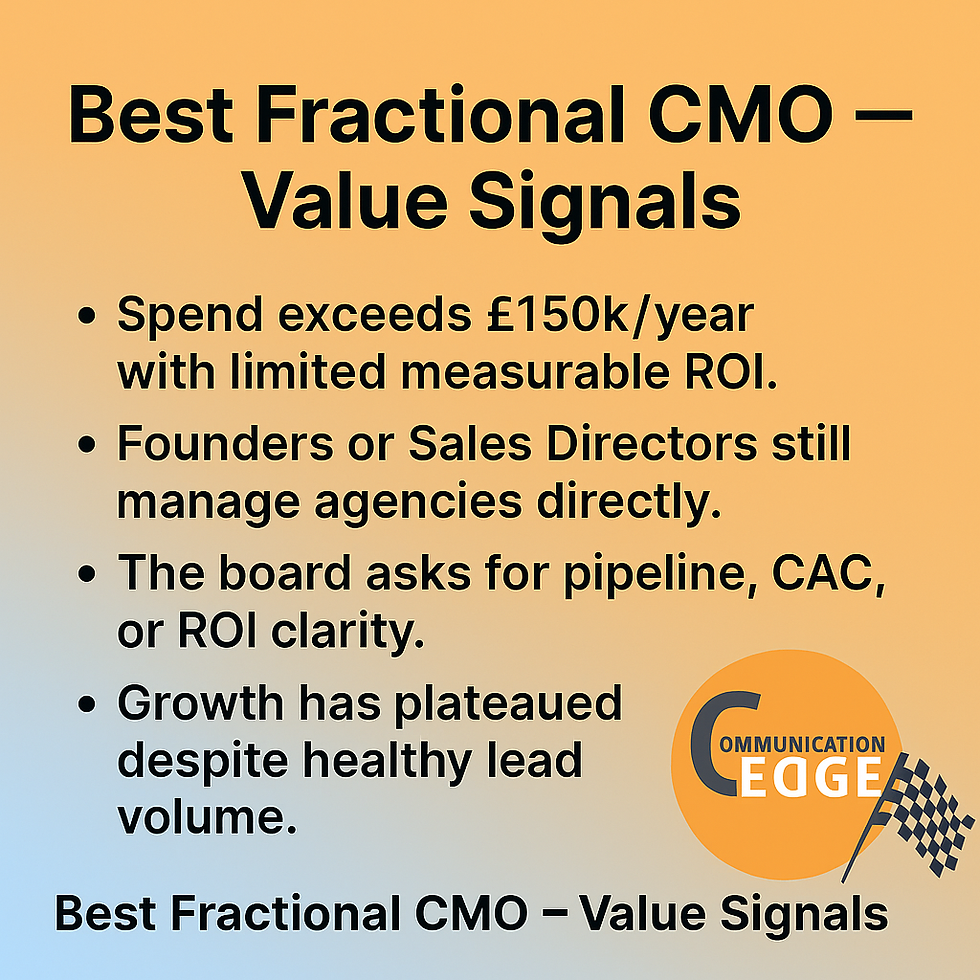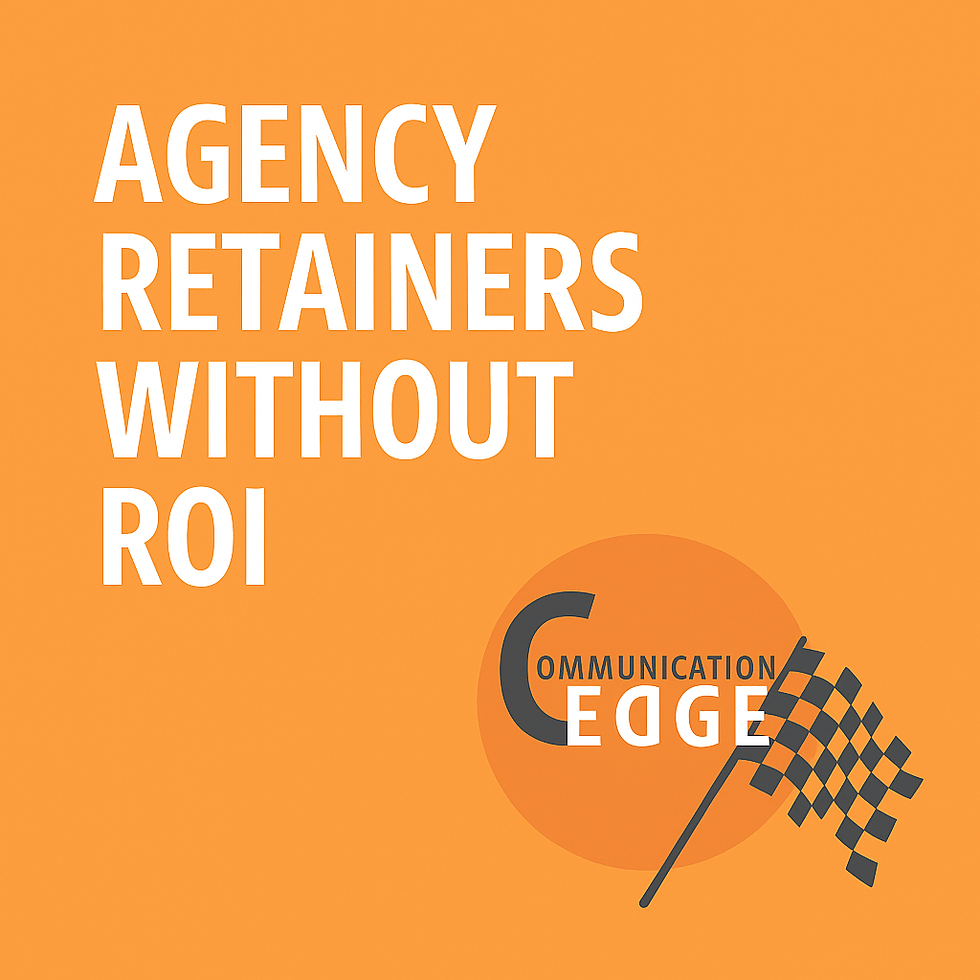Mistakes SMEs Make in Marketing with Agencies - No Marketing ROI
- Simon Hunt
- Oct 13
- 9 min read
Updated: Oct 18
1. Paying for Retainers Without Defined Outcomes and Marketing ROI
Many SMEs sign £3–6k/month retainers with no clear deliverables or ROI expectations.
Fix: Demand measurable goals — traffic growth, lead volume, CAC reduction, or pipeline value. If the agency can’t tie activity to numbers, it’s not strategic marketing.
We recently reviewed a Technology Companies Agency Spend and results and here are the crimes we witnessed:
Spend : £25k a month
Leads Generated Zero
Symptoms:
Frustrated MD,
Dependant on PPC and activities rather than "lead generation"
Website of 20 pages of which 17 were not ranked in Google.
Why?
No one had looked at Google Lighthouse and measured the page load speeds:
Mobile 16 secs.
Desktop 3 seconds.
Impact
Google down ranked the site.
Organic traffic was 1/130th of what it was 2 years prior.
PPC Spend £5k a month - no leads at all for 5 months.
Why?
The campaign was directed at the home page, which didn't load for 16 secs on mobile & 3 seconds on a desktop device.
Impact
They had wasted £25k.
They had targeted 30 keywords.
Not the 200+ transactional and commercial keywords required to generate 14 leads.
The business required 30 leads a month to keep the 2 sales guys employed.
2 Campaigns were running not the 7 that should have been to generate 30 leads.
Action
Remove access to the website content management system from 4 people who were doing different tasks and not reviewing what they did or the subsequent site performance.
Appoint a profession webmaster to manage the site performance with "ownership" of 90 or higher across all of Google Lighthouses - performance metrics.
Rebuild the base site on templates - not HTML from the ground up.
Pause the PPC campaign that was generating nothing but draining cash.
5. Review the PPC campaign against this Checklist.
Build one campaign properly and hold the PPC campaign builder to account for 14 leads a month.
Review the campaign metrics daily with the owner - extracting learns and tweaking the campaign to optimise the conversion rates.
Evaluate that PPC owners tools & content deployed & ensure the Full Marketing Funnel metrics are in place on Databox - which consolidates data from different sources. See this comparison of Databox V Looker Studio as to why we selected Databox
The Full Funnel Metrics measured are here
Use Pay Per Click, which will cost £10-12k a month, for 4 quarters as follows:-
2 Quarters - Full Spend
1 Quarter - 75% Spend
1 Quarter - 50% Spend
Whilst The PPC campaign is running evaluate all other marketing spend to establish a clear Return on Investment.
Find £54k of economies across the £300k marketing budget and appoint 2 Content publishers
1 SEO
1 Video
Build 7 Pillar Pages - 1 for each solution and sector
Build 35 cluster pages that hang off the Pillar Pages
Build 70 Blogs that relate to the targeted Keywords
At the moment they are ranking for 42 keywords average position 64 ie page 6
Target the easiest traffic keywords with the most volume in descending order
The right number of keywords to target 843.
How did we identify them? - SERanking see blog.
What did we do? - analyse the 4 competitors keywords

Build SEO Content by targeting the Keywords:-
To rank for 5% in the Top 10 Quarter 1
To rank for 15% in the top 10 Quarter 2
To rank for 20% in the Top 10 Quarter 3
To rank for 30% in the top 10 Quarter 4
The Opportunity is demonstrated by reviewing the competitors Keywords - 1333 in number:-
Of which 843 keywords have search volume.
You will note 65,000 searches a month for relevant keywords.
The Agency so far has not made any progress aside from a blog with structured data, which is less than desirable.
The key is that at £10-11k a month for PPC to produce 30 leads £333 a lead needs managing down longer term.

Cost per lead strategy
Two interns costing £54k plus a fractional CMO £36k, gives you a lower cost per lead of £90k / 300 = £300 year 1.
However, once you have built and "SEO Wall of Content", you can repurpose one intern and drop the cost to £63k / 300 Year 2
Effectively cutting the cost per lead to £210 (if you set the whole Fractional CMO against the Search Engine Optimisation initiative.)
From 65,000 searches a month, 2,166 a day the assumption is an SEO strategy will not bite for 6 months. But in Quarter 3 & 4 the PPC budget can be backed off.
What is Clear is that:
With Half the marketing budget we can generate 30 leads a month and true marketing ROI.
That Cost of Client Acquisition can be reduced by 25% by reducing the enquiry generation costs using SEO and a longer term plan.
2. Confusing Activity with Results
Agencies often highlight “output” (blogs, ads, posts) instead of “outcomes” (leads, conversions, revenue).
The Review had no End to End Dashboards covering the three stages of the marketing funnel.
We suggest the Fix: Separate marketing activity metrics from commercial KPIs. Focus on what impacts your bottom line.
3. Accepting Vanity Metrics
Metrics like impressions, clicks, and followers sound good — but they rarely prove ROI.
No focus on growth in numbers that matter, Leads, Marketing Qualified Leads, Landing Page performance.
Fix: Measure conversions, CAC, LTV, and cost per qualified lead. If it doesn’t tie to revenue, it’s noise.
4. No Transparency in Reporting
Agencies frequently hide behind complex PDFs or selective data.
Make sure you measure the impact NOT the activity.
The numbers are not linked and the goals are Form completion, Brochure downloads NOT
Landing Page conversion which would have identified the broken Web Pages.
Fix: Insist on live dashboards (Looker Studio, Databox) that show real-time results — with UTM tracking for every campaign with an end to end funnel Dashboard system so activity becomes just the means of "getting commercial results"
5. Outsourcing Strategy Instead of Owning It
When strategy sits with an external agency, you lose control of direction and insight, learning, and ownership / accountability sit with effectively the agency "marking their own homework".
Fix: Keep strategy in-house (Fractional CMO or internal lead) and use agencies purely for execution or specialist tasks.
6. Not Aligning Marketing with Sales Goals
Agencies often optimise for engagement, not pipeline.
Example a PPC Campaign with no "Lead Generation Target" to Ground it.
Fix: Build a shared KPI framework — marketing and sales aligned around leads, conversions, and closed-won revenue.
7. Ignoring Customer Acquisition Cost (CAC)
Most agencies never discuss the real cost of acquiring a customer they will just suggest different ways of spending money on different alternatives, eventually either they run out of ideas or you run out of patience waiting for results.
Fix: Calculate CAC vs. LTV regularly — if CAC is rising, your marketing is inefficient.
8. Failing to Track Campaign Attribution
Without tracking, you can’t tell which channels are driving conversions.
Fix: Implement UTMs, CRM tagging, and multi-touch attribution models to trace leads from first click to closed deal.
9. Over-reliance on Agency Tools & Data
Agencies often keep analytics in their own systems — meaning you lose visibility if you switch provider. It also means they can access and select which numbers to show you rather than the full funnel conversion.
Fix: Make sure all data sits in your accounts (GA4, Ads Manager, CRM). You own it, not them.
10. Not Reviewing Agency ROI Quarterly
Many SMEs never run performance reviews against spend.
Fix: Treat your agency like a supplier — hold quarterly ROI reviews and adjust scope or budget based on evidence.
11. Letting Creative Take Priority Over Conversion
Campaigns look great, but fail to convert.
Fix: Prioritise conversion rate optimisation (CRO) over design awards — test, refine, and iterate continuously.
12. Ignoring Competitor Benchmarking
Agencies rarely show where you stand in the market.
Fix: Demand SEO and PPC competitor gap reports — rankings, traffic share, content strength — to guide strategy.
13. Not Setting Clear Briefs or KPIs
Vague briefs lead to vague results.
Fix: Start every engagement with a written scope, SMART objectives, and success metrics agreed upfront.
14. Accepting “Black Box” SEO or PPC
Some agencies hide what they actually do — claiming it’s “proprietary.
”Fix: Require transparent task logs and access to campaign accounts. No black boxes, ever.
15. Staying in Long Contracts Without Performance Clauses
Lock-ins protect agencies, not clients.
Fix: Negotiate rolling 90-day contracts tied to measurable performance — if results don’t materialise, you can pivot.
16. Ignoring Speed and Agility
Agencies can take weeks to launch a campaign or make changes.
Fix: Move to an agile model (Fractional CMO + Interns) where planning and execution cycles are measured in days, not months.
17. Not Owning the Tech Stack
From CRMs to ad accounts, agencies often control your access.
Fix: Always retain admin rights for GA4, Ads, HubSpot, and reporting tools — your data, your systems.
18. Failing to Link Marketing to Commercial Reporting
Board members see spend, not return.
Fix: Integrate marketing dashboards into board reporting — showing lead source, conversion rate, and ROI trends.
19. Overpaying for Basic Work
Design tweaks, ad copy, and reporting shouldn’t cost thousands.
Remember experienced Agency staff will be on £45k plus, they will be marked up 60-90% and they are not assigned to you full time.
So here's the Maths:
Agency Costs:
An Account Manager £60k
2 Marketing Exec's at £45k
That gives you a cost of £150k plus budgets in Agency heads alone.
Fractional CMO & Intern
A Fractional CMO @ £1,000 a day 3 or 4 days a month - remember for every hour of activity there is normally, an hour of prep and an hour of follow up. Cost £43,000
Two Interns £54,000
Budget Headcount Fractional CMO & Interns = £97k
Summary
Hence 33% less cost and you'll get:
10× faster execution
15× more output
20x more value
Fix: Automate with AI and use trained interns for execution — managed by a senior Fractional CMO.
20. Not Building Internal Capability
Agencies don’t up-skill your team — they keep you dependent.
Fix: A Fractional CMO model trains your people, documents processes, and leaves you stronger, not reliant.
Summary
SMEs lose the most when they delegate accountability.
A Fractional CMO + AI-Intern model replaces opaque retainers with measurable performance:
30–40% lower cost
10× faster execution
15× more output
100% transparency
20X more value.
Next step: Book a Free Marketing Health Check to uncover where your agency spend can be redirected into measurable growth.
FAQs: Common Mistakes SMEs Make in Marketing with Agencies
1. Why do SMEs waste money on agency retainers?
Because many agencies sell activity, not outcomes. Without agreed deliverables or measurable KPIs, retainers quickly turn into cost centres rather than growth engines.
2. How can I tell if my marketing agency is delivering ROI?
Ask for clear metrics — cost per lead, CAC, pipeline value, and ROI per channel. If you can’t see this data in a dashboard, you’re not getting full visibility.
3. What’s the danger of confusing activity with results?
Agencies often showcase volume — posts, blogs, ads — instead of performance. True results are measured in qualified leads, conversions, and revenue growth.
4. Why are vanity metrics a problem in marketing?
Metrics like impressions or followers may look impressive but don’t prove return. Track conversion rate, CAC, and revenue attribution instead.
5. How do I fix poor transparency in agency reporting?
Request live dashboards such as Looker Studio or Databox. Real-time metrics stop selective reporting and show what’s actually driving ROI.
6. Should marketing strategy sit with the agency?
No. Strategy should always be owned in-house by your leadership or a Fractional CMO. Agencies are best used for execution under clear direction.
7. Why do agencies rarely align with sales goals?
They optimise for engagement, not revenue. A shared KPI framework that connects marketing to pipeline and closed-won deals fixes that gap.
8. What’s a healthy Customer Acquisition Cost (CAC) for SMEs?
It varies by sector, but your CAC should fall as campaigns optimise. If it’s rising, your spend is inefficient or your funnel needs re-engineering.
9. How do I track which marketing channels drive leads?
Use UTM parameters, CRM tagging, and multi-touch attribution to follow each lead from first click to closed deal.
10. Why do agencies keep control of my data and tools?
Many run campaigns inside their own GA4 or Ads accounts. Always ensure admin rights sit with you — your data, your systems, your control.
11. How often should I review agency ROI?
Quarterly. Treat your agency like any other supplier: review spend versus outcomes and adjust based on performance.
12. Why do creative campaigns fail to convert?
Because design isn’t tested against behaviour. Prioritise CRO — fast-loading pages, clear CTAs, and A/B testing — before worrying about style.
13. How can SMEs benchmark against competitors?
Use SEO tools like SERanking to compare keywords, rankings, and content performance. Competitor gap analysis reveals where to win traffic fast.
14. What’s wrong with long-term agency contracts?
They remove accountability. Use rolling 90-day performance contracts tied to measurable KPIs instead.
15. How can SMEs become more agile in marketing?
Replace layers of approvals with smaller teams — a Fractional CMO for strategy and interns for rapid execution. You’ll cut lead times dramatically.
16. Why is owning the tech stack important?
Because data drives decisions. Losing access to your CRM, GA4, or dashboards means losing control of your performance insight.
17. How can marketing data reach the board level?
By linking campaign data directly into dashboards tracking CAC, pipeline, and ROI. That’s what makes marketing accountable to the board.
18. Why do SMEs overpay for basic marketing work?
Because agencies mark up labour 60–90%. With AI and trained interns, you can cut costs 30–40% and produce 15× more output.
19. How does a Fractional CMO reduce waste?
They focus spend on what works — tightening tracking, re-allocating budget, and aligning activity with business goals.
20. How do I move from dependency to capability?
Adopt a model where your team learns and owns the process. A Fractional CMO trains interns, documents systems, and leaves you stronger, not reliant.




Comments